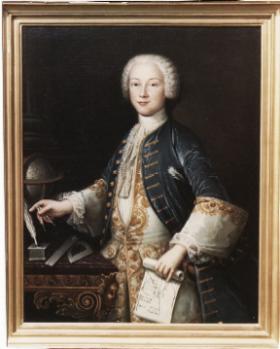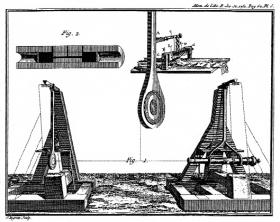A dynamic Irishman in Paris: Patrick d’Arcy, 1725–79
Published in 18th–19th - Century History, Features, Issue 2 (March/April 2010), Volume 18
Patrick d’Arcy in 1742, aged seventeen. Artist Hubert Druais depicts an elegant and confident young man, surrounded by the implements of his studies and holding the pages of one of two memoirs on dynamics just presented to the Académie Royale des Sciences, Paris. (Private collection)
Patrick d’Arcy was born on 27 September 1725 in Kiltulla Castle, four miles south-east of Athenry, Co. Galway, the third son of John d’Arcy and his wife Jane, daughter of Robert Lynch of Castle Carra, Co. Mayo. The family were Catholics and ardent Jacobites and as a result suffered under the Penal Laws. In order to escape oppression, Patrick’s parents smuggled him out of Galway on his uncle’s wine-merchant ship bound for Bordeaux. Here Patrick stayed with his uncle, James d’Arcy, and his wife Jane Martin, who ran a very successful winery. Patrick then moved on to Paris under the watchful eye of another uncle, Martin d’Arcy, who had followed James Edward Stuart into exile in France and who had became a wealthy property-owner in Paris.
At the age of fourteen Patrick d’Arcy was placed under the eminent mathematician Monsieur Claude Clairaut. He studied alongside the latter’s son, Alexis, and both were to become pioneers of Newtonian mathematics. Alexis is noted for his work on Halley’s comet. In this environment Patrick d’Arcy was soon to develop extraordinary ability in mathematics, mechanics and physics. In 1742, aged seventeen, he presented two memoirs on dynamics to the Académie Royale des Sciences, Paris. To commemorate this outstanding achievement his portrait was painted by the renowned French artist Hubert Drouais (1699–1767). He became a member of the Academy in 1749 and its director in 1775. Many of his essays were published in the Histoire et Memoires de l’Académie Royale des Sciences.
Angular momentum
Patrick d’Arcy’s best-known work today is his contribution to dynamics and his part in the discovery of the principle of angular momentum, which he called ‘the principle of areas’, an important concept in both physics and engineering, with numerous applications. In 1749 he collaborated with Jean Baptiste Le Roy in attempts to develop a floating electrometer. He embarked on a series of debates with Maupertius on ‘the principle of least action’, published in 1749 and 1752. His memoirs of 1751, 1760 and 1766 on the theory of artillery focused on the physics and chemistry of gunpowder mixtures, the dimensions of cannon and the placement of the charge. In measuring the recoil and power of a cannon he invented his Momentium Pendulum (see illustration), which was adopted by the Régie des Poudres (Gunpowder Board).
Optics

D’Arcy’s Momentium Pendulum for measuring the recoil and power of cannon. (Académie des Sciences de Paris)
D’Arcy’s service in the French army (see below) left his sight impaired. Consequently he began to investigate optics in a 1765 essay, ‘Visual Perception’. He carried out ingenious experiments on visual persistence and measured its duration with precision. The phenomenon had been known, but d’Arcy devised a way to determine its duration based on ‘a casual comment’ in Newton’s Opticks; A Treatise of the Reflections, Refractions, Inflections and Colours of Light (1704). He constructed a wooden cross, mounted on an axle, the angular velocity of which he would record; by attaching a glowing coal to one arm of the cross, he was able to determine the angular velocity at which the ember appeared as a complete circle. He adopted a method of limits by either increasing the angular velocity until a complete circle was first seen, or decreasing it from a high velocity until the circle ceased to be visible. D’Arcy conducted many manipulations of the viewing conditions. He derived similar values of visual persistence from there, namely eight thirds of a minute or about 130ms. This previously unmeasured and unrecorded phenomenon was highly praised by the Académie Royale des Sciences, for it was to act as a major catalyst in further experiments which led to the invention of the cinema.
His scientific interests were wide—he was responsible for bringing water to the city of Dijon, where Place d’Arcy is named after him. He had an interest in mines, had a share in the Mines de Basse Bretagne company and invented new methods of extracting carbon. His study of the planets and of the precession of the equinoxes occupied him in his memoirs of 1758 and 1759.
Military career

A ‘lost’ portrait of d’Arcy in later life that formerly hung at Clifden Castle, Co. Galway.
Although first and foremost a scientist, he also had an eventful military career. Enlisting as a captain in the Condé regiment, he campaigned in Flanders and Germany. He fought at Fontenoy in 1745 and was aide-de-camp to Marshal Saxe. A year later he was captured and imprisoned in the Tower of London while sailing to help Bonnie Prince Charlie in Scotland. After the failure of the ’45, Count d’Herouville and d’Arcy carried out a survey of the Irish coast in anticipation of an invasion of Britain and to free Ireland, but nothing came of the plan. At the outbreak of the Seven Years’ War in 1756 d’Arcy was a colonel in the FitzJames Irish Horse regiment and fought at the battle of Rosbach in 1757, where he was promoted to brigadier. The peace of 1763 restored him to his scientific studies. In 1770 he was appointed marechal des camps.
He died, aged 57, on 18 October 1779 from cholera in his home in the Faubourg du Roule, Paris. He was replaced in the Académie Royale des Sciences by his friend Nicolas de Condorcet (1743–94), who wrote his Eloge de M. le Comte d’Arcy in 1779. A note in the Dublin Freeman’s Journal on 1 October 1845 states:
‘A mason employed at the ancient Chapel of St Philip du Roule has discovered a leaden coffin of ancient form . . . A brass plate bears the following inscription: “Here lieth Messire Patrick Count d’Arcy, Académie des Sciences, Commandant of the Order of St Lazarus and Mount Carmel, Knight of the Royal and Military Order of St Louis and General in the Armies of the King aged 57 years, deceased October 1779. Requiescat in Pace. The Curé of St Philip has given orders to lower the coffin into the vaults of that Church”.’
He rests there still. HI
Carlovian Mary Stratton Ryan is an artist and art historian.
Further reading:
M. Redington, ‘An eminent Galwayman’, Journal of the Galway Archaeological and Historical Society (1918) [English translation of Condorcet’s Eloge].
N.J. Wade, ‘Descriptions of visual phenomena from Aristotle to Wheatstone’, Perception 25 (1996).
















